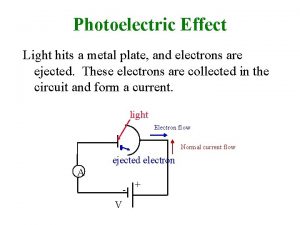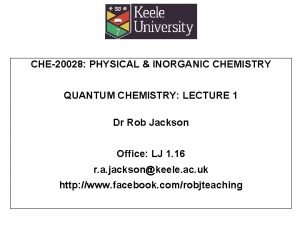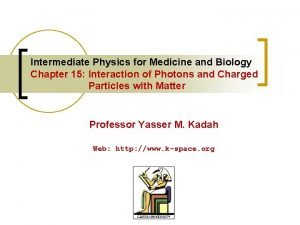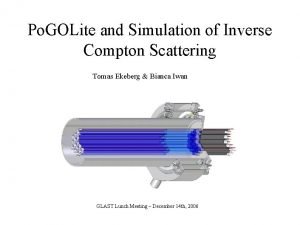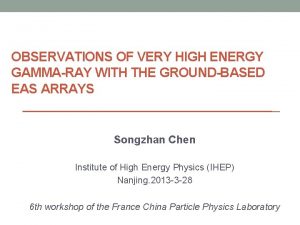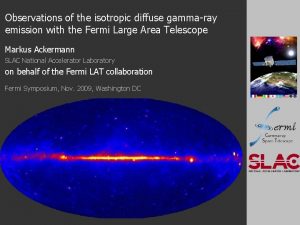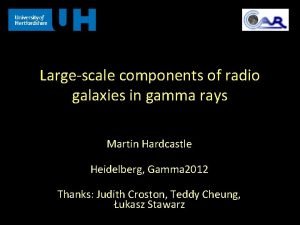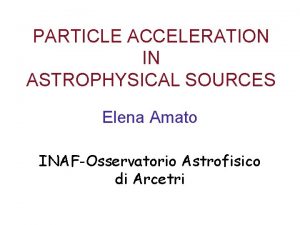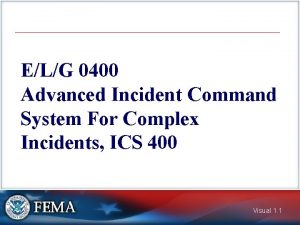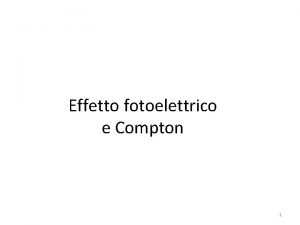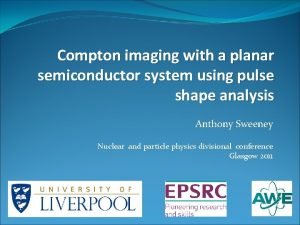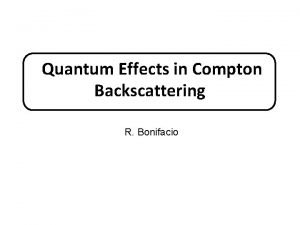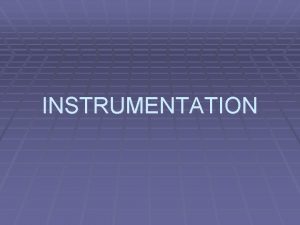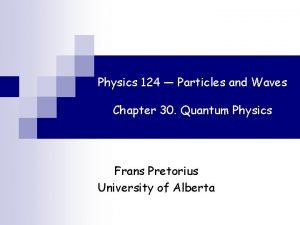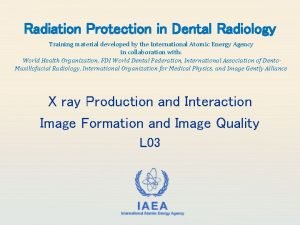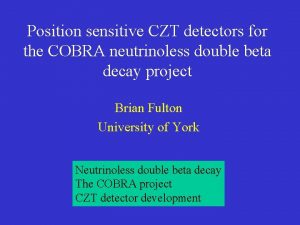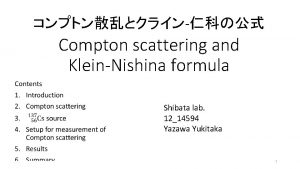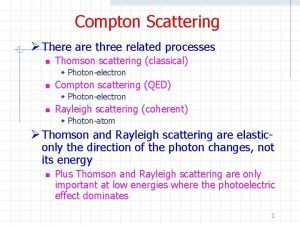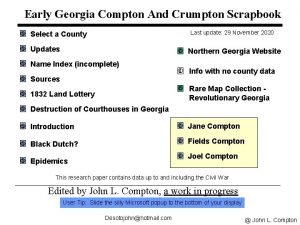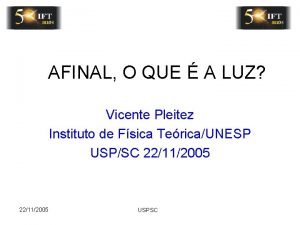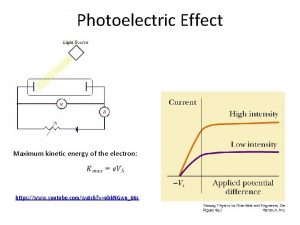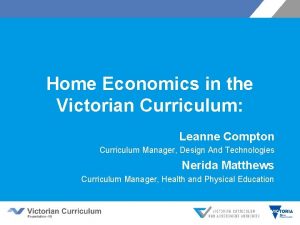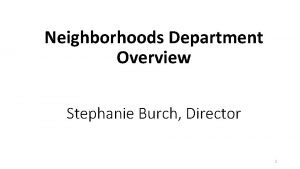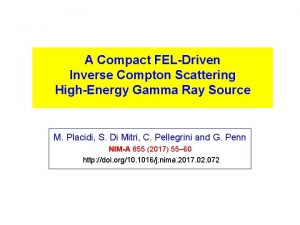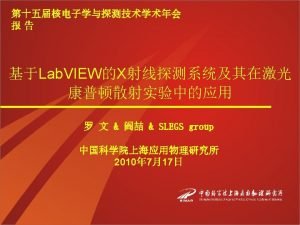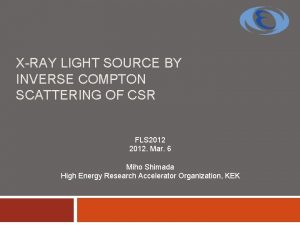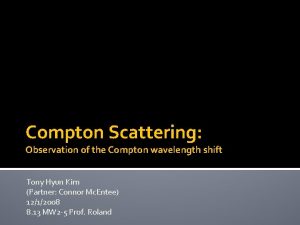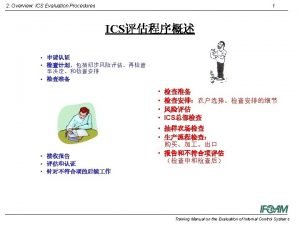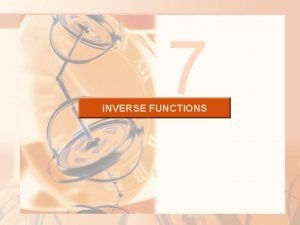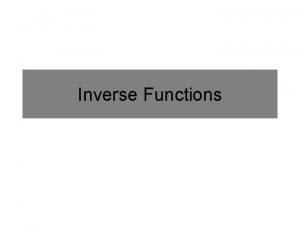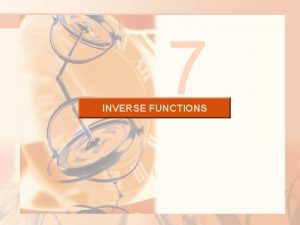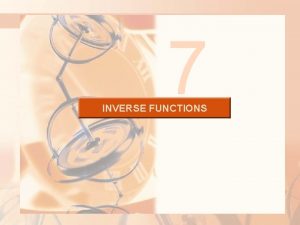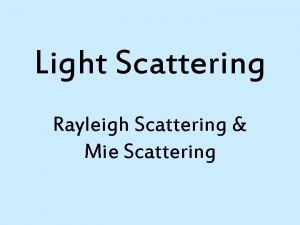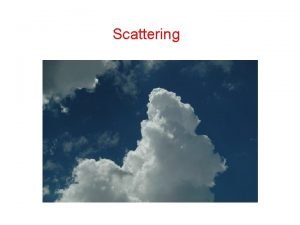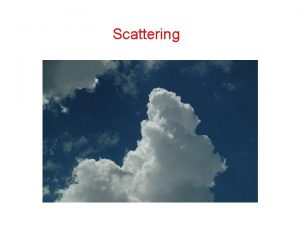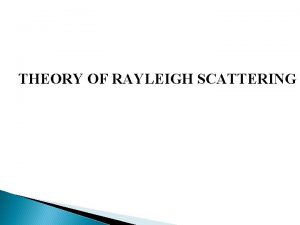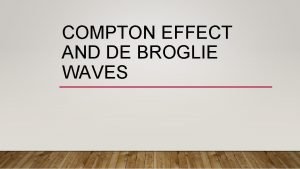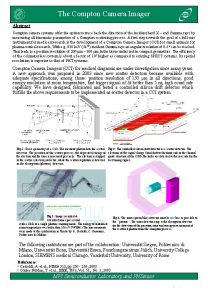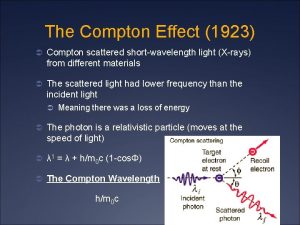An Inverse Compton Scattering ICS Source for HighEnergy

























- Slides: 25

An Inverse Compton Scattering (ICS) Source for High-Energy, Time-Resolved X-ray Scattering Studies of Structural Materials Joel D. Brock, Vaclav O. Kostroun, G. Hoffstaetter, Bruce Dunham Cornell University, Ithaca, New York 1 ERL Workshop

Outline 1. Motivation for studying structural materials a. New lightweight materials b. New fatigue failure diagnostics and understanding 2. Characteristics of “ideal” x-ray source for characterizing structural materials 3. Basics of an Inverse Compton Scattering (ICS) hard x-ray source 4. Current capabilities of 3 rd generation and XFEL sources 5. MIT concept utilizing an optical cavity 6. Combination of MIT cavity with existing Cornell ERL components a. Table of design parameters and performance b. Calculated spectral curves c. Floor plan/layout of source 7. Additional scientific applications 2 ERL Workshop

Motivation for Novel Structural Materials 1. Lighter weight structural materials enhance fuel efficiency in airplanes, trucks, and cars. 2. Improved diagnostics and/or understanding of fatigue failure will reduce need to replace expensive parts well before expected lifetime in critical applications. 3. Improved engineering design tools. Modern Engineering Design begins with (e. g. , using finite element methods) each component (e. g. , a nut or a bolt) and then couples them together to build a model of a system (e. g. , an airplane). At the lowest level, materials are assumed to be homogeneous and are modeled using Macroscopic elasticity theory and experimentally obtained stress/strain curves, measured yield stress, etc. Goal is to incorporate the microstructure of structural materials into the design process. 3 ERL Workshop

Modern Engineering Design System 4 ERL Workshop

Modern Engineering Design Sub-system System 5 ERL Workshop

Modern Engineering Design Part Sub-system System 6 ERL Workshop

Modern Engineering Design Component Part Sub-system System 7 ERL Workshop

Modern Engineering Design Component Part Modelling breaks down at the materials level Sub-system System 8 ERL Workshop

Microstructure-Based Modeling (Owen Richmond - US Steel, Alcoa) 9 ERL Workshop

Microstructure-Based Modeling (Owen Richmond - US Steel, Alcoa) “Polycrystal” Models 10 ERL Workshop

Mechanical Design with Structural Alloys • • Function, Constraint, Objectives Constraints & Objectives based on properties – Strength, Stiffness, Density, Cost • Mechanical Tests: stress-strain data – Extract Properties – Validate and Calibrate Material Models – Drag the model through “Gauntlet” of data • Implement models within design methodologies - FEM – Understand heterogeneous deformation • Microstructural Characterization – Microstructure dictates properties – Ever more highly resolved “images” (3 D) 11 ERL Workshop

Mechanical Design with Structural Alloys • • Function, Constraint, Objectives Constraints & Objectives based on properties – Strength, Stiffness, Density, Cost • Mechanical Tests: stress-strain data – Extract Properties – Validate and Calibrate Material Models – Drag the model through “Gauntlet” of data • Implement models within design methodologies - FEM – Understand heterogeneous deformation • Microstructural Characterization – Microstructure dictates properties – Ever more highly resolved “images” (3 D) 12 ERL Workshop

Mechanical Design with Structural Alloys • • Function, Constraint, Objectives Constraints & Objectives based on properties – Strength, Stiffness, Density, Cost • Mechanical Tests: stress-strain data – Extract Properties – Validate and Calibrate Material Models – Drag the model through “Gauntlet” of data • Implement models within design methodologies - FEM – Understand heterogeneous deformation • Microstructural Characterization – Microstructure dictates properties – Ever more highly resolved “images” (3 D) 13 ERL Workshop

Mechanical Design with Structural Alloys • • Function, Constraint, Objectives Constraints & Objectives based on properties – Strength, Stiffness, Density, Cost • Mechanical Tests: stress-strain data – Extract Properties – Validate and Calibrate Material Models – Drag the model through “Gauntlet” of data • Implement models within design methodologies - FEM – Understand heterogeneous deformation • Microstructural Characterization – Microstructure dictates properties – Ever more highly resolved “images” (3 D) 14 ERL Workshop

HEXD and FEM Modeling HEXD – Transmission – Near and Far Field Detectors Grain Maps – Evolving intensity distributions • Spots – individual grains • Rings – distribution of grains – In situ loading and residual strains FEM – – – Crystal scale elastoplastic deformation Assemble polycrystal Mimic loading of HEXD sample Deformation of individual grains Comparison to data: virtual diffractometer 15 ERL Workshop

Experimental Challenge 16 ERL Workshop

Inverse Compton Scattering W. S. Graves, W. Brown, F. X. Kaertner, and D. E. Moncton, "MIT inverse Compton source concept, " Nuclear Instruments and Methods in Physics Research Section A: Accelerators, Spectrometers, Detectors and Associated Equipment 608 (1, Supplement 1), S 103 -S 105 (2009). As the electron oscillates in its rest frame, it radiates (Thompson Scattering) at the same wavelength as the (doppler shifted) incident radiation. Back in the laboratory frame however this radiated electromagnetic has received another doppler shift: 17 ERL Workshop

MIT Design Yb: YAG Oscillator Yb: YAG Preamp Yb: YAG Multi-pass amp Diodes Enhancement cavity SRF RF amp photo. Bunch compressor injector 1 m. A, 25 Me. V electron beam SRF linac 6 m 1. 5 m 18 ERL Workshop

Combine an Enhancement Cavity with an ERL Higher energy beam from FFAG/ERL (to reduce angular divergence) + high average electron beam current (rep rate), plus enhancement cavity to increase flux -> high flux, high energy, time-resolved hard x-rays 19 ERL Workshop

Combine an Enhancement Cavity with an ERL Higher energy beam from FFAG/ERL (to reduce angular divergence) + high average electron beam current (rep rate), plus enhancement cavity to increase flux -> high flux, high energy, time-resolved hard x-rays X-ray output 20 ERL Workshop

Comparison to MIT Design # of x-rays generated per pulse Time-average spectral brightness 21 ERL Workshop

Simulated Performance* - 76 Me. V E = 76 Me. V, 100 p. C 1 um laser wavelength 50 m. J per pulse 100 MHz enhancement cavity Produces a flux of over 1 x 1013 photons/s *Three-dimensional time and frequency –domain theory of femtosecond x-ray pulse generation through Thomson scattering”, W. J. Brown and F. V. Hartemann, Phys. Rev. STAB 7, 060703, (2004) 22 ERL Workshop

Simulated Performance - 286 Me. V E = 286 Me. V, 40 p. C 1 um laser wavelength 50 m. J per pulse 100 MHz enhancement cavity Produces a flux of over 1 x 1013 photons/s With a 1 um laser, produces 1550 ke. V photons, so in reality we would use a 10 um laser to get 150 ke. V photons. 23 ERL Workshop

Brightness Plot with ICS Source ICS/ERL source 24 ERL Workshop

What else could you do with this? 1. Structural Materials: (e. g. , Matt Miller – Cornell) a. If can focus to 0. 1 µm spot, then can raster hard x-ray beam. b. Rastering eliminates grain size challenge – all materials (especially real ones) are now open for study. 2. Time-resolved Diffraction Studies: (e. g. Aaron Lindenberg - Stanford) a. Picosecond x-ray pulses (high energy, high flux) are not available anywhere else – including XFELs. 3. Time-resolved or Spatially Resolved Pair Distribution Function Studies: (e. g. , Simon Billinge – Columbia) a. High energy (150 ke. V) x-rays b. Small Spots c. Short pulses 4. With shorter laser wavelength (or higher beam energy), we can generate gamma ray beams for nuclear physics, astrophysics and nuclear material studies. 25 ERL Workshop
 Photoelectric effect สรุป
Photoelectric effect สรุป Equivalent dose formula
Equivalent dose formula Compton scattering
Compton scattering Conservation of momentum
Conservation of momentum Compton scattering
Compton scattering Inverse compton
Inverse compton Inverse compton
Inverse compton Inverse compton
Inverse compton Elena amato
Elena amato Advanced incident reporting system
Advanced incident reporting system Compton olayi
Compton olayi Effetto compton
Effetto compton Compton
Compton Compton backscattering
Compton backscattering Compton
Compton Compton wavelength
Compton wavelength X ray protection
X ray protection Bad sight
Bad sight Gammra
Gammra Photon cross section
Photon cross section Gwinette county court
Gwinette county court Fóton
Fóton James dewey watson y francis harry compton crick
James dewey watson y francis harry compton crick Www.youtube.com
Www.youtube.com Leanne compton
Leanne compton Stephenie compton email
Stephenie compton email
